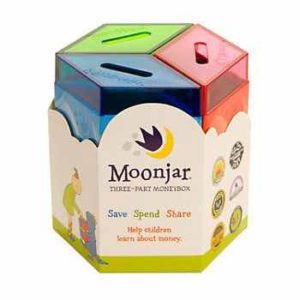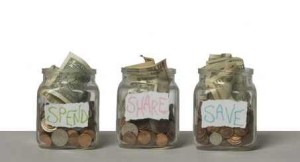As soon as Lily starts seeing the dollars build in her jar, she wants to spend it. The concept of money is still new to her, and she hasn’t quite grasped that things don’t cost what she wants them to. For instance, she wanted to go buy a new Lego creation a few weeks ago. She was REALLY upset to find that her $5 wasn’t going to buy the $99.99 Lego set. Earning and saving money is definitely a concept that kids don’t grasp overnight, but when instilled in them at an early age, can be impactful throughout their adult lives.
Part of what comes with earning money is the urge to SPEND money (true for kids AND adults). You have heard the phrase “That money is burning a hole in your pocket!” That phrase rings true in little folks, who in the early stages of learning about money, only know that you need it to buy things. One way we have tried to explain it to our daughter is quantity versus quality. Yes, you can buy five items from the Target $1 bin, OR you can buy ONE $5 toy that is bigger/better/flashier. Or, even better, you can save that $5, and add $5 or $10 or $20 or $100 more to it and buy your Lego set.
Along with saving for that “big ticket” item, we want Lily to start to look at the bigger picture, so we have a method to help her learn to do so, and this method seems to be effective at any stage of the saving game.
On pay day, she must split their earnings three ways: spending, saving, and giving. If she earns $6, $2 goes to each category. (If you wanted to get fancy, you can look for things like Moon Jars, which come pre-divided into three sections.) Since I work at a bank, we were gifted several piggy banks when Lily was born, so we repurposed those and opened a bank account for her. On pay day, we get the mason jar and pull out all the money she has earned. We count it out and make a big deal out of “paying” her. Then, we go through it and divide it into 3 equal piles and she puts it in her spend pig, her giving pig, and then we have the “save” envelope that she can take to the bank. (Side Note: If you have an uneven amount of money, like say, $10.00, it is up to you and your situation where that extra $1 should go. We generally have Lily place it in savings, unless she’s really close to having enough money for a toy she’s wanted for a while. The idea is that ultimately, your child will learn to save the extra.)
Spending: In order to make saving money fun and not something with a negative connotation (such as “I never get to do anything FUN!”), it’s as important to give your child the opportunity to SPEND as it is to SAVE. It is completely up to your child when, where, and how this money is used. If she wants to take it to school and buy 30 erasers with it immediately, ok. If he has his eye on a new video game, he may decide to hang on to his spending money longer. There should be little to no pressure from Mom and Dad about how the money should be used. Kids will learn that they can get more “bang for the buck” if they hang on to their spending money, essentially learning to be more frugal and less frivolous. You probably will go through a money is burning a proverbial hole in your child’s pocket phase, but it doesn’t really take long for them to realize that they don’t want a bunch of little trinkets when they can hold on to that cash for a few weeks and get something bigger and cooler.
Saving: This cash can either go into a piggy bank or a bank account. I recommend a children’s savings account. First, it will earn interest, and even at 1% or 2%, that absolutely adds up over time. Secondly, it’s “out of sight, out of mind”. I have found, if we leave the money in a piggy bank, we’re more apt to let Lily “steal” a few bucks.
Giving: I am going to get more in depth with this in Part 3, but the concept is exactly what you think. It teaches children to be charitable, and to consider sharing their financial success by helping those who aren’t as well off. This is extremely impactful in helping children to learn that their financial successes should not allow them to be greedy, and should, instead, enhance a giving heart.
You’ll soon see that, even at 6 or 7 years old, kids see the benefit in holding on to their money for better things. As they grow, it will be easier for them to focus on the “prize”, whether it be a car, college text books, or a dream senior trip. Before they ever get into the “real world”, they’ll have a working idea of how to keep their money working for them, and financial responsibility.
I hope you’ll come back next time to read the final post of this series, Part 3: Saving With a Giving Heart.

















